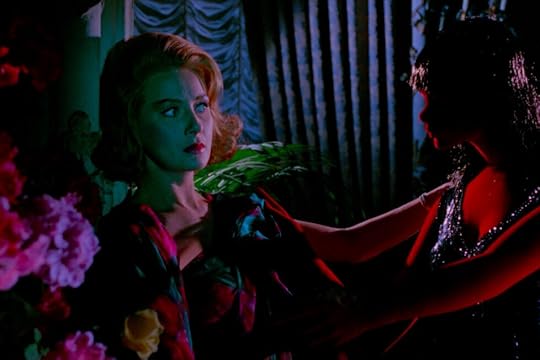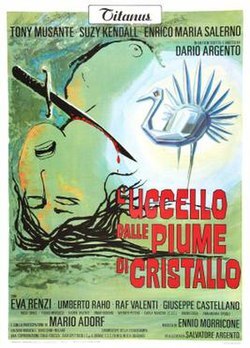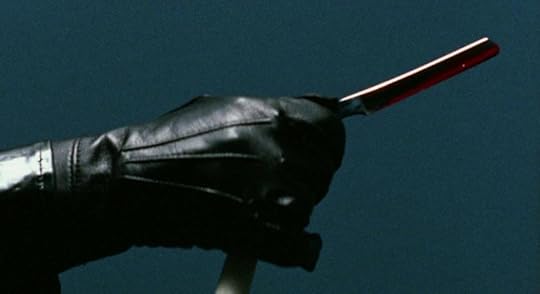A Quick Guide to Giallo
My next horror novel is still very early in the process, with only a couple of thousand words penned so far, but I’m excited about it and can let you know a few things. I’ve been into Gialli movies for a few years now, and have long wanted to write a novel inspired by them. For the uninitiated, a ‘giallo’ movie is an Italian mystery/suspense/thriller with a dash of horror that was hugely popular in the 1960s and 1970s.
Giallo means ‘yellow’ and has been retroactively used as a label for a certain kind of movie that was popular in Italy from the mid-1960s to the early 1980s. Giallo refers to the yellow covers of mystery paperbacks that were published by the Italian publishing company Arnoldo Mondadori Editore in the early part of the 20th century. Giallo paperbacks were often Italian translations of English language mystery novels by the likes of Agatha Christie, Edgar Wallace and Raymond Chandler. The success of Mondadori’s giallo paperbacks saw other publishing houses follow suit with their own versions (also with yellow covers). Giallo thus became a synonym for a mystery novel.
 The ‘I Gialli Mondadori’ series by Italian publisher Arnoldo Mondadori Editore started in 1929 and largely featured translations of English-language mystery novels by the likes of Agatha Christie.
The ‘I Gialli Mondadori’ series by Italian publisher Arnoldo Mondadori Editore started in 1929 and largely featured translations of English-language mystery novels by the likes of Agatha Christie. But the giallo paperbacks of the early 20th century are a far cry from the more lurid content of its cinematic counterpart in the latter half of the century which had a greater emphasis on horror and sex. While crime and mystery films were nothing new in Italian cinema (1943’s Ossessione based on James M. Cain’s The Postman Always Rings Twice – a novel which actually appeared in Mondadori’s giallo series – being a notable example), the stylish brand of films that came to be known as ‘giallo’ did not emerge until the 1960s. Director Mario Bava, who had pioneered Italian horror with his directorial debut La maschera del demonio (Black Sunday) in 1960, led the way with his 1963 movie La ragazza che sapeva troppo (The Girl Who Knew Too Much).
Widely regarded as the first giallo, The Girl Who Knew Too Much is a Hitchcock-influenced tale of an American woman in Rome who witnesses a murder and, dismissed by the authorities, attempts to solve the murder on her own. Despite being shot in black and white (thus lacking the genre’s stylized use of color) the film’s plot established a common trope for gialli to come. Bava’s 1964 followup, 6 donne per l’assassino (Blood and Black Lace) defined the genre further. Gorgeously shot in lurid Eastmancolor, it involves a series of murders in a Roman fashion house connected to an incriminating diary. Blood and Black Lace brought together all the elements that would become staples of the genre such as the eroticism, violence, use of color and the masked killer with the black gloves.
 Mario Bava’s use of style, color, eroticism and violence in Blood and Black Lace (1964) paved the way for the giallo genre.
Mario Bava’s use of style, color, eroticism and violence in Blood and Black Lace (1964) paved the way for the giallo genre. Despite its later cult status, Blood and Black Lace was not a huge hit on release. The honor of popularizing giallo fell to Dario Argento’s 1970 directorial debut L’uccello dalle piume di cristallo (The Bird with the Crystal Plumage). Following the template of The Girl Who Knew Too Much, Argento’s classic sees an American in Italy witness a murder and then struggle to solve the mystery while avoiding the killer’s attempts to silence him. A massive box office success, Bird with the Crystal Plumage spawned many imitators and the 1970s saw a slew of gialli that tried to ape its success.
 Dario Argento’s 1970 directorial debut – Bird with the Crystal Plumage – popularized the giallo movie and spawned countless imitators.
Dario Argento’s 1970 directorial debut – Bird with the Crystal Plumage – popularized the giallo movie and spawned countless imitators. The names of Bava and Argento would dominate the giallo genre for the rest of the decade, and the two would make some of the most highly regarded entries including Bava’s Ecologia del delitto – A Bay of Blood (1971) and Argento’s Profondo rosso – Deep Red (1975), the latter of which is often cited as the pinnacle of the genre.
While it may be tempting to lump gialli in with another popular Italian genre of the ’60s and ’70s – the poliziotteschi movie – there are marked differences. Poliziotteschi films, influenced by tough American cop movies like Bullitt (1968) and Dirty Harry (1971), were more action-orientated and usually dealt with mafiosi and bank robbers rather than the crimes of passion and madness so often seen in gialli.
 The gloved hands of a killer; one of the most identifiable images of the giallo genre.Gialli often feature outsiders as protagonists, with many inadvertently witnessing a murder as in Bird with the Crystal Plumage and Deep Red, or are investigating a murder as in Don’t Torture a Duckling (1972) and Black Belly of the Tarantula (1971). In other examples, such as Lizard in a Woman’s Skin (1971) and The Case of the Scorpion’s Tail (1971), the investigators end up being accused of murder themselves. Several gialli were a strong influence on the slasher genre, especially A Bay of Blood, and Torso (1973) which deal with groups of companions in isolated locations, being picked off by a mysterious killer. The giallo genre remains a tricky thing to pin down. Rather than being defined by rules relating to plot structure, it is best identified by style and tone. The following checklist brings together the main ingredients of a giallo though, not all gialli include every item on the list.
The gloved hands of a killer; one of the most identifiable images of the giallo genre.Gialli often feature outsiders as protagonists, with many inadvertently witnessing a murder as in Bird with the Crystal Plumage and Deep Red, or are investigating a murder as in Don’t Torture a Duckling (1972) and Black Belly of the Tarantula (1971). In other examples, such as Lizard in a Woman’s Skin (1971) and The Case of the Scorpion’s Tail (1971), the investigators end up being accused of murder themselves. Several gialli were a strong influence on the slasher genre, especially A Bay of Blood, and Torso (1973) which deal with groups of companions in isolated locations, being picked off by a mysterious killer. The giallo genre remains a tricky thing to pin down. Rather than being defined by rules relating to plot structure, it is best identified by style and tone. The following checklist brings together the main ingredients of a giallo though, not all gialli include every item on the list. 1. A stylish, contemporary setting. Gialli often take place in chic, retro settings such as the fashion house in Blood and Black Lace and the pop art villa in Five Dolls for an August Moon (1970). Playboy photographers and journalists often feature as protagonists against a backdrop of space age airports, swank penthouses and psychedelic nightclubs with lots of shag, lava lamps and mod design.
2. Sex. As much as violence, gialli are known for their sexual content. This isn’t just the voyeuristic quality of the genre which often showcases the woman’s body in states of undress. Psychosexual motives often play a part in the murders, with madness, perversion and childhood trauma being the driving force behind the killings.
3. Murder from the killer’s point of view. Remember those shots from Michael Myers’s POV in Halloween (1978) and most slasher movies since? That’s straight from giallo.
4. Black gloves. If we don’t see the killer’s actions from their POV, then we almost always see the killer wearing a slick, black raincoat, a brimmed hat (to conceal their face) and shiny, black gloves.
5. A whodunit plot with a focus on suspense rather than horror. Generally speaking, a giallo should contain no supernatural elements. While they are often gory, violent and seemingly akin to slashers, gialli remain focused on the element of mystery.
6. Obscure and baroque titles often containing numbers or references to animals. Why? No idea, but reflect on these; Bird with the Crystal Plumage, Four Flies on Grey Velvet, The Bloodstained Butterfly, The Iguana with the Tongue of Fire, The Case of the Scorpion’s Tail, The Red Queen Kills Seven Times and Seven Deaths in the Cat’s Eye.
7. A bottle of J&B Rare. OK, this one is far from essential or unique to the genre, but this popular brand of scotch from yesteryear with its distinctive green bottle and red and yellow label, appears with remarkable frequency in giallo movies. The reason isn’t quite clear but it always symbolizes the stylish and the masculine. A ’70s macho drink if ever there was one!
 Lucio Fulci’s 1972 classic ‘Don’t Torture a Duckling’ shows Barbara Bouchet as Patrizia in her chic apartment (along with a bottle of J&B).
Lucio Fulci’s 1972 classic ‘Don’t Torture a Duckling’ shows Barbara Bouchet as Patrizia in her chic apartment (along with a bottle of J&B).As the 1980s approached, Italian cinema began to change. The popularity of Dawn of the Dead (in particular Dario Argento’s Italian cut of the move entitled Zombi) resulted in a deluge of cheap knockoffs and unofficial sequels. In addition to this, the success of American slasher movies like Halloween (1978), itself heavily influenced by the giallo genre, resulted in a bigger focus on horror movies in Italy. Suspense was ditched in favor of gore and special effects and the popularity of the taut and intricately plotted giallo began to wane. Even Argento and Bava turned to more supernatural subject matter with Argento’s Suspiria and Bava’s Shock (both 1977) often mistakenly referred to as gialli when, in reality, they land somewhere between giallo and the Italian horror boom of the 1980s.



